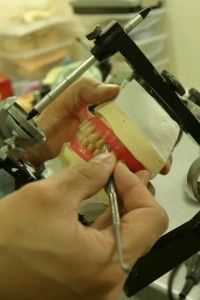Specialist Dental Group has launched an on-going series of blog posts by our individual dental specialists. All views provided are the dentist’s own opinions and are posted on this blog as part of our on-going efforts to educate the public about dental issues and other matters of interest relating to dentistry and healthcare.
 Being in prosthodontics and dentistry in the last 20 years has been a very interesting experience. The development of computer technology has changed the landscape of dentistry dramatically. Those of us who are of a certain vintage may still remember the days when computers were meant for “Pacman” games and storage of a few bytes of data would require a ‘floppy disk’ that literally flopped in our hands. Little did we know, two decades later, that it is all possible to keep numerous radiographs, CT scans and patient information on a single hard disk that is measured in terabytes. It is practically impossible to visualise what the future computer storage format may be.
Being in prosthodontics and dentistry in the last 20 years has been a very interesting experience. The development of computer technology has changed the landscape of dentistry dramatically. Those of us who are of a certain vintage may still remember the days when computers were meant for “Pacman” games and storage of a few bytes of data would require a ‘floppy disk’ that literally flopped in our hands. Little did we know, two decades later, that it is all possible to keep numerous radiographs, CT scans and patient information on a single hard disk that is measured in terabytes. It is practically impossible to visualise what the future computer storage format may be.
With computers integrated into our daily life, the field of dentistry has not been spared. Computer assisted design and computer assisted manufacturing (CAD-CAM) have also changed the nature of prosthodontics. Most of us in prosthodontics were trained in the ‘manual era’, i.e. all good prosthodontic work with a high level of precision had to be fabricated by manual means by highly trained hands. Nowadays, CAD-CAM procedures allow the fabrication of predictable restorations with great reduction of possible human errors. The integration of digital imaging and computer software has also evolved into fancy implant treatment planning.
At the time when I was in the dental school, prosthodontics was known as fixed crown and bridge or removable prosthesis. The term “prosthesis” implied that the replacement teeth were meant to be ‘fake’. Back then, implantology was more a research interest rather than a predictable clinical treatment modality. For more than one time, I had heard of senior clinicians dismissing dental implants as a research vanity. However, my personal experience with dental implants at UCLA, Northwestern University, Chicago and the University of Toronto, Canada has showed otherwise. From the time when the University of Toronto announced their research results on osseointegration in 1982, the ‘news’ of osseointegration has spread like wildfire. As of 2012, most of the meaningful prosthodontic training programs are a 3-year full-time combined program of fixed, removable and implant prosthodontics.
The original osseointegration concept mainly focused on replacing teeth in a predictable functional manner for the fully edentulous mandible (i.e. toothlessness in lower jaw) in the older population. More and more work has been done since and implant treatment has moved from fully edentulous cases to partially edentulous cases where the new teeth are made to look, feel and bite exactly like natural teeth in adult patients. From multiple stage procedures over a period of 6 months to a year in the past, the completion of the new implant teeth can be accomplished even before an incision is made in some selected cases.
Who knows, may be one day, we will have robotic prosthodontic procedures in the form of computer screen navigation…
Dr. Ansga r C. Cheng is a Dental Specialist in Prosthodontics (Teeth Replacement) with Specialist Dental Group™. He is also an Adjunct Associate Professor with the National University of Singapore. He has a special interest in dental implants, cosmetic dentistry and treatment of medically compromised patients, including cancer patients. For more information about Dr. Cheng, click here
r C. Cheng is a Dental Specialist in Prosthodontics (Teeth Replacement) with Specialist Dental Group™. He is also an Adjunct Associate Professor with the National University of Singapore. He has a special interest in dental implants, cosmetic dentistry and treatment of medically compromised patients, including cancer patients. For more information about Dr. Cheng, click here





